Developing fine and gross motor control through play
Development | | Gail Miles
By Gail, The Playful Expert
Play is crucial to the development of children’s fine and gross motor skills. Through play, children practice and perfect control and coordination of large body movements, known as gross motor skills, as well as the coordination of small muscle movements, known as fine motor skills.
Motor skills are essential for a child’s physical strength and movement. They are used every day and throughout their lives. They help us move and do everything from lifting, walking and running to eating our food, speaking, singing and writing on a keyboard. Motor skills and motor control begin developing from when a child is born and progress as the child grows.
Motor skills are broken up into two categories: gross motor skills and fine motor skills. Mastering both is essential to help support your child throughout their lives. If they are unable to do everyday tasks, it will affect their self-confidence, ability to develop self-care and independence skills and their academic performance.
Gross motor skills and your little one's development:
Gross motor skills are the development of movements related to large muscles, such as those within the legs, arms, head and torso.
Gross motor skills are important to everyday physical activities like walking, lifting, kicking, running and throwing.
Around the 15-month mark, your child will be working on:
• Walking up the stairs using their hands or using the rail to help
• Crawling/sliding down the stairs (feet first)
• Running (though they may fall easily)
• Kicking a ball forward
By exploring many different types of movement, your child will start to build their confidence, motivation and physical competence to engage in an active lifestyle.
Here are some ideas to help your child to develop these gross motor skills:
• Mini obstacle course: To provide your child with the opportunity to climb up, down, over, under and through things.
• Dry land: Pretend that there are sharks/crocodiles in the water and you need to jump onto ‘dry land’ to escape danger!
• Catching games e.g. Tag: Encourage your child to run at different speeds whilst trying to catch them (they will find this very exciting!)
• Bunnies: Pretend that you are bunnies that hop.
• Pedalling ride-on toys: Encourage your child to start to pedal on trikes or ride-on toys (start with push along and build up to pedalling if needed).
• Pushing and pulling: Provide different items that require pushing or pulling - trolleys, brushes, pushchairs or prams and pull along toys such as a waddling duck.
•Targets: Throwing and catching balls of different sizes.
Gross motor development also forms the basis for fine motor skills and relates to body awareness, balance, reaction, speed and strength.
Fine motor skills and your child's development:
Fine motor skills involve the careful control of the small muscles in the hands, fingers, feet, toes, lips and tongue as well as the coordination of the hands with the eyes.
Developing the muscles in the hands, wrists, fingers, feet and toes includes actions like grasping, holding, pressing, or using a pincer grip (holding something between the fore-finger and thumb).
Control of the tongue and lip muscles is important for singing and speaking, a fine motor skill that requires development too.
Fine motor skill development also involves vision, specifically visual motor skills, often referred to as hand-eye coordination. Visual-motor skills are required to coordinate the hands, legs, and the rest of the body with what is seen.
Around the 15-month mark, your child will be working on*:
• Using a spoon and cup
• Using both hands to play
• Clapping their hands together
• Putting objects and toys into containers & shutting lids
• Waving goodbye
• Isolating their index finger with other fingers closed
You can develop these fine motor skills further through these suggested activities:
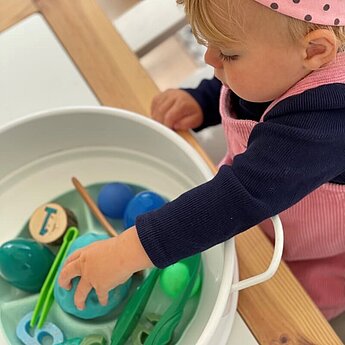
• Playdough/plasticine/clay: Tactile play with materials like playdough, plasticine or clay is a great way to allow your child to experiment and build their fine motor skills. If your child is still mouthing items, I would suggest making a taste-safe playdough so that you know exactly what they are putting in their mouths! Here’s a recipe that shows you how to make your own playdough. You can also encourage them to use tools such as scissors and cutters or give them loose parts to play with too (size dependent for safety of course).
• Building with Blocks (of various shapes and sizes): Stacking and building with blocks encourages fine pushing and pulling movements. Providing opportunities to build with blocks not only helps to foster creativity, persistence, a sense of accomplishment and an improved ability to solve problems/puzzles, it also helps to build stronger muscles in their hands and improves coordination, which contributes toward learning to hold a pencil in the future.
• Water Play: Use different containers, cups or jugs to fill and pour water out, alongside sponges to squeeze too. This can be done outside so that you don’t need to worry about a mess or place a waterproof mat or shower curtain underneath your child, so that you can easily wipe up afterwards.
• Threading and lacing: Provide different items such as buttons, beads, pasta or hooped-shaped cereal to thread onto string, pipe cleaners or laces. Your child will love doing this and it’s great to see their little concentration faces when giving this activity a go!
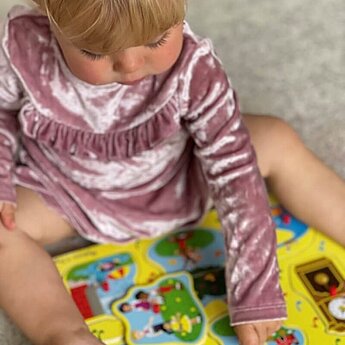
• Puzzles: Playing with puzzles of varying size handles or knobs helps with developing the pincer grasp by picking up and moving the pieces into place.
It can be frustrating watching your child learn how to complete puzzles, as they can be quite impatient and give up easily or put the pieces anywhere but in the puzzle (usually in their mouth!). However, if you persevere and provide lots of opportunities for them to practise, the rewards are well worth it. Try offering easy puzzles at first and engaging with them as much as possible, then progress on to harder ones, as this will improve their hand-eye coordination and motor skills.
• Scissors: You’re probably thinking it’s way too early to be giving my 15-month-old a pair of scissors – however, there are some plastic play-safe scissors that can be used to ensure safety at all times!
• Drawing, painting and colouring: Encourage your child to start drawing and painting. You may think they are too young – but you’d be very surprised at how they can make their mark already! It not only helps their fine motor skills, but their creativity and imagination too. Try using different paints, brushes, markers, crayons, and large chalk that are all child-safe to encourage and spark their interest and strengthen their hand-eye coordination. Painting with items such as brushes also helps them gain greater control of their hands.
• Tweezers or tongs: Provide opportunities for your child to start using tweezers or tongs to pick up items, initially of a larger size and then progress onto smaller items to increase the fine motor skill development of those muscles further. You could create a game where they need to pick up items and place them in a bowl.
• Sand play: As with water play, using cups, containers and jugs to fill and pour out sand is fantastic fun! Your little one may dislike the feeling of sand to start with, but will soon realise just how great it is. The more exposure to sensory materials like this, the better, as it allows sensory development. Use tools such as spoons, scoops and moulds to build things and create in the sand. If you are inside, use a sheet on the floor or large container underneath, so that the mess can be tidied up easily.
• Shared reading: Shared reading is also a great time to encourage fine motor skills with your little one. They can turn the pages of the book and lift flaps whilst you discuss what is happening on each page. I’d suggest board books for this age range, as they are sturdier and easier for them to manipulate.
What to do if you’re concerned
*Remember each child is different, especially when it comes to their physical development and the development of muscles relating to motor skills – these examples are provided as a guide and it may not be noticeable until your child reaches school that they may have problems with their balance or coordination. If you have any concerns relating to your child’s development, it is best to discuss this with their health visitor or your GP, who will be able to provide further support if needed.

